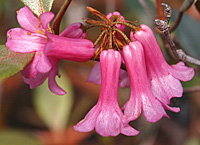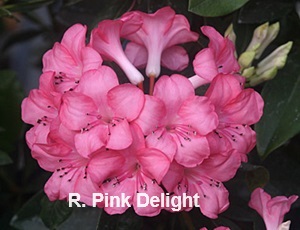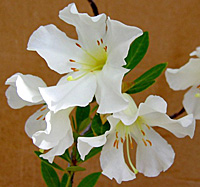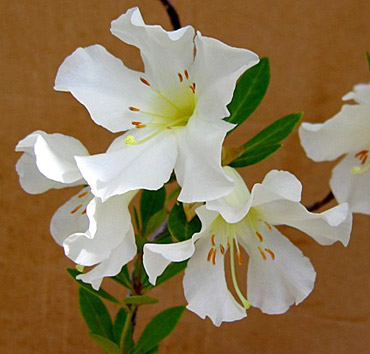The History of Vireya Rhododendron Culture


Rhododendron malayanum
The first published description
of a vireya, Rhododendron malayanum (pictured right),
appeared in 1822 based on material collected by the author,
William Jack, on Mt. Bunko (now Bengkoh) in Sumatra, while
working for the East India Company. In 1826 a further five
species were described by Carl Blume, the director of what
is now the Bogor Botanic Garden, who also proposed a new genus
Vireya, in honour of his friend Julian Joseph Virey.
The rank of genus was rejected by Blume's peers however the
name continued to be used for this Section (now Subgenus)
of the genus Rhododendron.
It was not until 1845 that the first live vireyas were introduced
into cultivation in Britain by Thomas Lobb, working for the
famous Veitch Nurseries. Lobb successfully brought home five
species and these were supplemented shortly after by a further
two species introduced by Charles Curtis, also working for
Messrs. Veitch, bringing the total to seven - Rr. javanicum,
jasminiflorum, brookeanum, longiflorum,
malayanum, multicolor and teysmannii,
although R. brookeanum and R. teysmannii
are now considered to be subspecies of R. javanicum.
From this group of species, more than 500 hybrids were raised
by the nursery including a number of double-flowered 'balsamaeflorum'
cultivars, the latter unfortunately since lost. Of the rest,
only a handful remain in cultivation today - Rr.
'Ne Plus Ultra', 'Clorinda', 'Triumphans', 'Princess Alexandra',
'Princess Royal', 'Pink Delight' (pictured below) and 'Souvenir
de J.H. Mangles'.
The latter half of the 19th century saw vireyas at the peak
of their popularity as more species were collected, notably
by the Italian, Odoardo Beccari, but for many growers their
place in the glasshouse became second to that of the new orchid
introductions. Their fall from favour was later hastened by
the influx of new hardy rhododendron species from China and
the Himalayas. With the advent of World War One few people
continued to grow vireyas - a heated glasshouse a luxury afforded
by only botanic institutions and a few large estate owners.
Ironically, despite this decline in cultivation, the number
of new species being described at this time increased markedly.


Rhododendron 'Pink Delight'Discovery of gold
in New Guinea in 1929 led to the previously uncharted interior
of the country being opened up by prospectors and mining companies.
This in turn paved the way for enterprising botanists to follow
in their footsteps and so the number of known vireya species
continued to increase, albeit more slowly than before.
By the 1950s interest in vireyas was again increasing with
occasional articles appearing, led by C. R. Stonor's 'Rhododendrons
in New Guinea', published in the RHS Rhododendron Year
Book 1951-52, outlining some of the vireyas encountered by
the author during a visit to the country. (A copy of the article
is available in the Archive).
Around the same time, Professor Hermann Sleumer, working
at the Rijksherbarium in Leiden, Holland, commenced a revision
of Rhododendron for 'Flora Malesiana', having
a few years earlier published a new classification of the
genus organised into subgenera and sections, including Section
Vireya. Sleumer received large quantities of material
collected by several expeditions to New Guinea and in 1961
published descriptions of 122 new species of Vireya.
Sleumer's revision was published in 'Flora Malesiana'
in 1966 and an extract of this work entitled 'An Account
of Rhododendron in Malesia' appeared shortly thereafter,
detailing a total of 288 species of Rhododendron
within the region, the vast majority belonging to Section
Vireya. This account was to remain the standard reference
work on Vireya for the next 40 years until the publication
in 2006 of a further revision by Dr. George Argent of the
Royal Botanic Garden Edinburgh, 'Rhododendrons of Subgenus
Vireya'. This was the first full account of Vireya
to be produced, including not only all the Malesian species
covered by Sleumer but also all the outlying mainland species,
a total of 313 taxa. Dr. Argent also raised the taxonomic
rank of Vireya from Section to Subgenus, thereby
marking the importance of this group, representing as it does
around a third of all species within the genus Rhododendron.
By the early 1970s, interest in vireyas was once again growing,
particularly in Australia, New Zealand and the USA and several
dedicated collectors distributed seed freely to enthusiasts
as well as botanic gardens, thereby firmly establishing the
plants in cultivation. This rapid increase in the number of
available species duly led to the production of many new hybrids,
often growing with great vigour and displaying many of the
desirable characteristics of both parents.
Breeding programs by both enthusiasts and specialist nurseries
continue to this day and have resulted in many excellent second-
and even third-generation hybrids bearing flowers of great
beauty on quite compact plants, making them attractive additions
to modern greenhouse and conservatory culture as well as for
garden display in areas with a suitably mild climate.


Rhododendron mendumiaeThe renaissance in vireya
cultivation seems set to continue for the foreseeable future,
fired by a growing number of enthusiasts exchanging ideas,
information and plant material around the world, backed up
by the large plant collections of several botanic institutions.
Exploration of some of the more remote regions continues,
resulting in the introduction of species not previously seen
in cultivation and occasional new species still being discovered,
such as Rhododendron mendumiae (right), first found in the
Philippines in 1998.
An excellent, more detailed, account of the history of vireya
culture by Dr. George Argent entitled 'The Vireya Story' can
be found in 'The Rhododendron Story', edited by Cynthia Postan
(Royal Horticultural Society, London, 1996, pp.86-92).
|

|
